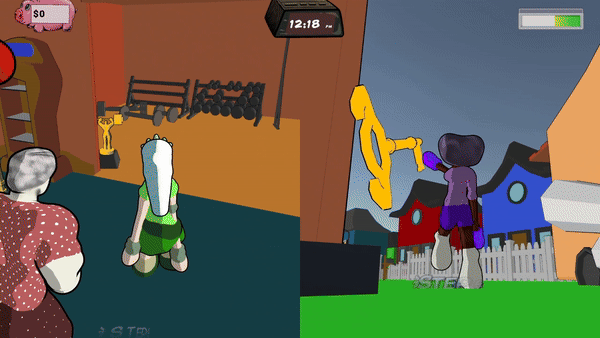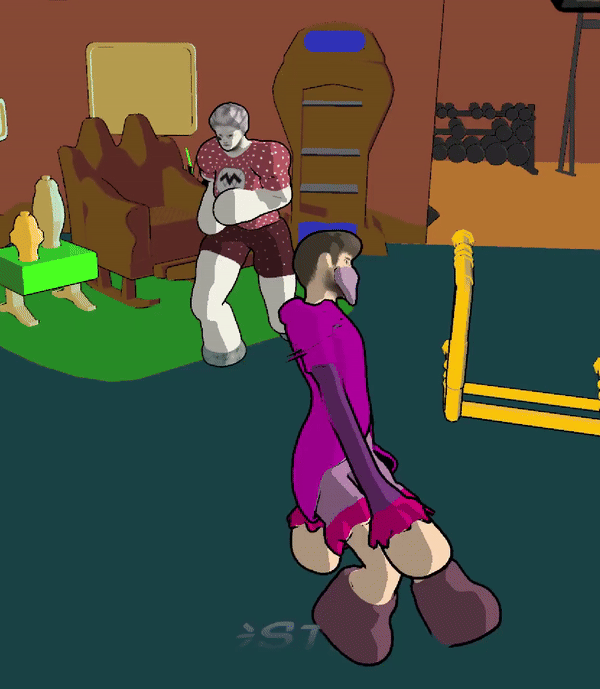
.png)

Project work summary
While working on Villainous Intent, I worked on level design. I created/iterated the level layout for the retired superhero's house. I also developed and implemented a physics-based prop system.
ProjecT Summary
A dastardly duo of supervillains are executing a heist on a retired superhero's home, so they can become the most reputable evildoers. Work together to steal anything that isn't bolted to the floor. Be careful though, as the retired superhero stands guard of their home and will detain you if you get caught! Use your superpowered teamwork to steal as much as you can, and claim your title as the most infamous evildoers.
Production Summary
Project Title: Villainous Intent
Project Platform: PC
Project Engine: Unity
Project Timeline: August 2024 - December 2024
My Role

As the primary level designer on Villainous Intent, I was tasked with bridging the gap between the design and art disciplines. I would often be tasked with implementing art assets into the levels. I regularly communicated with artists as to ensure that the art direction of the game was inline with the gameplay intent.
While working on the physics-based prop system, I bridged the gap between the design and programming disciplines. I worked closely with our physics programmer to ensure that the system worked the way we intended it to. The physics-based prop system also required collaboration with artists to ensure the models broke apart in satisfying ways.
Level Design Process
When it came to designing/iterating a level layout for Villainous Intent, my process could be broken down into six steps:
-
Identify what elements the level needed to include, in order to align the game's experience with the core gameplay pillars.
-
Draft concept sketches of the level with these considerations in mind.
-
Create a level graybox in engine based on the level sketch.
-
Implement physics-based destructible props into the level graybox.
-
Test the level to see if it created a space in which the gameplay highlighted the core gameplay pillars. Continue iterating and testing until it does.
-
Collaborate with artists to integrate art assets into the level


Physics-Based Prop System

When it came to designing/implementing the physics-based prop system for Villainous Intent, I had a pretty sold pipeline created, in order to get these assets functioning and in game as quickly as possible
To start, a set of assets from the team's environment artist would be sent over. Next, would be logical determination of which props made the most sense to break, specifically in a fracturing format. Once these assets have been determined, they would be imported to Blender. In Blender, a fracture mesh tool would be applied to the meshes. Clean up was done on the way the meshes fractured, to ensure they felt satisfying for the player.
Once the fracturing was complete, the normal and fractured models would be imported into Unity. Once in Unity, the meshes would be set up in the physics-based destruction system the team had developed (I prototyped it, the physics programmer polished it). This system caused the normal model to be switched with the fractured model upon a certain amount of force being applied to it. The system applied mass to the objects, which determined the force required to fracture it.

Post Mortem
Working on Villainous Intent taught me the importance of creating a game concept based on gameplay not aesthetics.
This allowed for the art direction to be very solid, but the substance of gameplay to be lacking. While Villainous Intent was able to develop an interesting and enjoyable gameplay loop, this didn't happen until much later into development. Not knowing the exact direction the gameplay loop was going, caused a large portion of work to be scrapped and redone.
Not knowing what the main loop of the game was going to be also made our core gameplay pillars hard to define. Without these pillars, it was hard for us to create an intended user experience, until later into development.


Villainous Intent also taught me the importance of not becoming too emotionally attached to a project. Villainous Intent, at the end of it's development cycle, was brought to a greenlight pitch. Villainous Intent wasn't greenlit for continued development and this was devastating. The amount of effort and care put into this project left me far too attached to the project. This experience gave me a better sense of what it's like to have a project cut that you deeply care about.
Visual Design Guide
Team Rotten Eggs
Producer: Eric Cowette
Product Owner, Systems Designer: Isaac Eddy
Level Designer: Liam Dunphy
Generalist Designer: Peter Newman
Environment Artist: Caleb Spainer
Character Artist: Renee Bamford
Physics Programmer: Xavier Olmstead
AI/Gameplay Programmer: Henry Bennett
Sound Designer: Danni Vecchione
